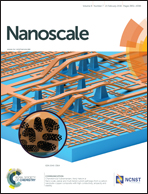A self-assembly aptasensor based on thick-shell quantum dots for sensing of ochratoxin A†
Abstract
A novel self-assembling aptasensor was fabricated by precisely attaching three phosphorothioate-modified capture aptamers onto a single thick-shell quantum dot in a controllable manner for monitoring of ochratoxin A (OTA), a poisonous contaminant widespread in foodstuffs. Herein, CdSe/CdS QDs coated in ten layer CdS shells were synthesized using a continual precursor injection method. Analysis of the prepared CdSe/CdS QDs showed a zinc-blende structure, high photoluminescence quantum yields (>80%), and a photoemission peak with a narrow full-width at half-maximum (about 29 nm), all qualities that render them as a superior choice for optical applications. By adjusting the number of phosphorothioate bases in the anchor domain, the tunable-valency aptasensor was able to self-assemble. In the sensing strategy, the thick-shell quantum dot was provided as an acceptor while OTA itself was used as a donor. In the presence of OTA, the capture aptamers drive the aptasensor function into a measurable signal through a fluorescence resonance energy transfer (FRET) system. The newly developed aptasensor had a detection limit as low as 0.5 ng mL−1, with a linear concentration in the range of 1 to 30 ng mL−1, and therefore meets the requirements for rapid, effective, and anti-interference sensors for real-world applications. Moreover, the high quality thick-shell QDs provide an ideal alternative for highly sensitive imaging and intensive illumination in the fields of biotechnology and bioengineering.


 Please wait while we load your content...
Please wait while we load your content...